 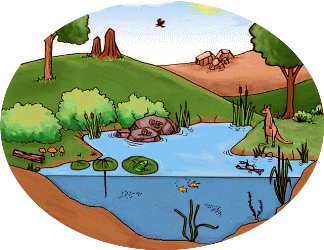 An ecosystem is an area where plants, animals, and other organisms, as well as weather and landscapes, work together to make a living system.
An ecosystem is an area where plants, animals, and other organisms, as well as weather and landscapes, work together to make a living system. Ecosystems contain living (biotic) and nonliving (abiotic) parts. Biotic factors include plants, animals, and other organisms. Abiotic factors include rocks, temperature, and humidity. Every biome has many different ecosystems within it. Ecosystems can be very large or very small. Everything in an ecosystem depends on everything else, either directly or indirectly. A change in the temperature will affect what plants grow there. Animals that depend on certain plants for food and shelter may live there by adapting, or move to another ecosystem. 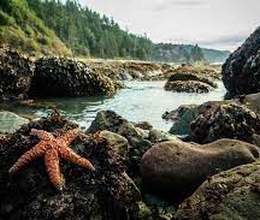 Tide pools, the small ponds left by the ocean as the tide goes out, are small ecosystems full of living things. They contain seaweed, which uses sunlight to do photosynthesis to create food. The seaweed gets eaten. Sea stars eat clams and mussels. Other organisms, such as hermit crabs, can't live underwater and depend on the shallow pools left by low tides.
Tide pools, the small ponds left by the ocean as the tide goes out, are small ecosystems full of living things. They contain seaweed, which uses sunlight to do photosynthesis to create food. The seaweed gets eaten. Sea stars eat clams and mussels. Other organisms, such as hermit crabs, can't live underwater and depend on the shallow pools left by low tides. In this way, the biotic parts of the ecosystem depend on each other for food, as well as on the abiotic factors like temperature and sunshine. The whole surface of Earth is a series of biomes, each containing many connected ecosystems. Forests, ponds, reefs, and tundra are all types of biomes. Within each forest, each pond, each reef, or each region of tundra, you'll find many different ecosystems. 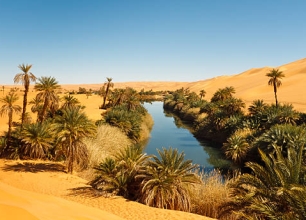 The biome of the Sahara Desert includes a wide variety of ecosystems. The arid climate may include vast deserts, but also supports oasis ecosystems, which have date palm trees, fresh water, and even crocodiles!
The biome of the Sahara Desert includes a wide variety of ecosystems. The arid climate may include vast deserts, but also supports oasis ecosystems, which have date palm trees, fresh water, and even crocodiles! The Sahara also has dune ecosystems, with the changing landscape determined by the wind. Organisms here, such as snakes or scorpions, must be able to survive in sand dunes for long periods of time. 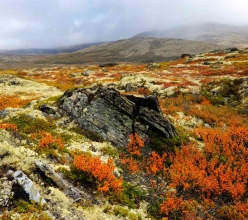 Tundra ecosystems are treeless regions found in the Arctic and on the tops of mountains, where the climate is cold and windy, and there is very little rainfall. Some plants survive in the mountain zones by growing in rock depressions. Tundra is covered with snow for much of the year, but summer brings a sea of wildflowers and flourishing wildlife.
Tundra ecosystems are treeless regions found in the Arctic and on the tops of mountains, where the climate is cold and windy, and there is very little rainfall. Some plants survive in the mountain zones by growing in rock depressions. Tundra is covered with snow for much of the year, but summer brings a sea of wildflowers and flourishing wildlife. A variety of animal species include Arctic foxes, polar bears, gray wolves, caribou, snow geese and musk oxen live in these ecosystems. The freezing desert ecosystems of Antarctica are ones that support only a few living things. Antarctica's thick ice sheet receives very little precipitation, hence the name 'desert'. Only a few mosses grow, supporting only a few birds. 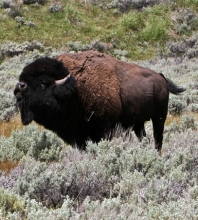 Bison became the most important biotic factor in many Plains Indians cultures. (Bison are sometimes mistakenly called buffalo). These tribes used buffalo hides for shelter and clothing, buffalo meat for food, and buffalo horn for tools. The tallgrass prairie of the Great Plains supported bison herds, which tribes followed throughout the year.
Bison became the most important biotic factor in many Plains Indians cultures. (Bison are sometimes mistakenly called buffalo). These tribes used buffalo hides for shelter and clothing, buffalo meat for food, and buffalo horn for tools. The tallgrass prairie of the Great Plains supported bison herds, which tribes followed throughout the year.
However, as human populations have grown, the tallgrass prairie ecosystem became farmland. Fewer bison could survive. Today, a few herds thrive in protected ecosystems in national parks in Canada and the U.S. 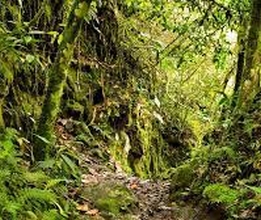 In tropical rain forest ecosystems surrounding the Amazon river, a similar situation is taking place. The rain forest has hundreds of ecosystems, including canopies, understories, and forest floors. Human activity threatens all these. Thousands of acres of land are cleared for farmland, housing, and industry.
In tropical rain forest ecosystems surrounding the Amazon river, a similar situation is taking place. The rain forest has hundreds of ecosystems, including canopies, understories, and forest floors. Human activity threatens all these. Thousands of acres of land are cleared for farmland, housing, and industry. But countries there are underdeveloped. Cutting down trees to make room for crops benefits many poor farmers. These resources give them a reliable source of income and food. Children can attend school, and families are able to afford better health care. 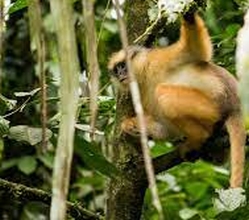 Canopy ecosystems are at the top of the rainforest, where tall trees grow in search of sunlight.
Canopy ecosystems are at the top of the rainforest, where tall trees grow in search of sunlight. Understory ecosystems exist under the canopy. They are darker and more humid. Animals such as monkeys live in understory ecosystems, eating fruits from trees as well as smaller animals like beetles. Forest floor ecosystems support a wide variety of flowers, which are fed on by insects like butterflies. Butterflies, in turn, provide food for animals such as spiders. The destruction of rain forest ecosystems has its costs. Many modern medicines have been developed from rain forest plants. Curare, a muscle relaxant, and quinine, used to treat malaria, are just two of these medicines. Many scientists worry that destroying the rain forest ecosystem may prevent more medicines from being developed. 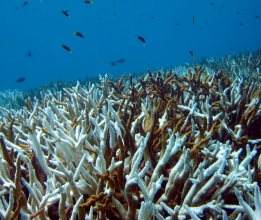 Ecosystems can recover from destruction, however. The delicate coral reef ecosystems in the South Pacific are at risk due to rising ocean temperatures and decreasing salinity.
Ecosystems can recover from destruction, however. The delicate coral reef ecosystems in the South Pacific are at risk due to rising ocean temperatures and decreasing salinity. Corals bleach in water that is too warm, and die in water that isn't salty enough. Without the reef, the ecosystem eventually collapses. Plants like algae and seagrass, and animals such as fish, snakes, and shrimp, all disappear. Some coral reef ecosystems will recover, if protected. Governments are working to preserve ecosystems that are important to them. The government of Ecuador, for instance, recognizes ecosystem rights in the country's constitution. Ecuador is home not only to rain forest ecosystems, but also river ecosystems and the remarkable Galapagos Islands ecosystems. Watch an incredible video about how the introduction of wolves into an ecosystem changed it completely, including changing the course of its rivers! |